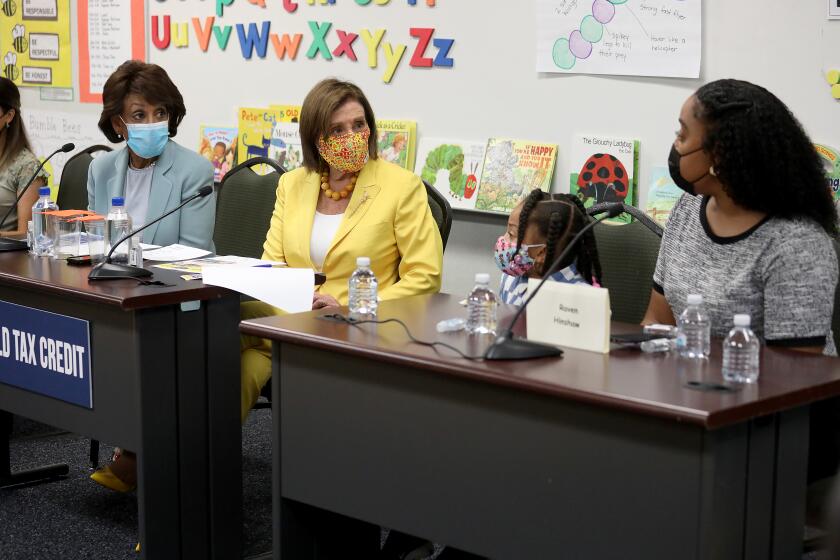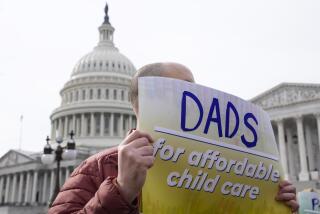Editorial: Childcare costs more than rent for many California families. That has to change

- Share via
Recent research lays bare an enormous toll facing California families: Child care has become so costly that in most of the state it’s surpassed housing as the largest monthly expense for households with young children.
Child-care costs have jumped 45% in Los Angeles County and an astonishing 81% in San Francisco since 2014 for households with two adults and both a preschool-age child and a school-age child, according to Insight Center, a research and advocacy group focused on economic justice. Such families in Los Angeles now typically spend $2,058 a month putting a roof over their heads — and $2,450 a month on child care.
Many families simply can’t afford that. While the state provides sliding-scale subsidies that cover some or all of the child-care costs for households that make less than the median income, it’s only enough to help 14% of eligible infants and toddlers. Care is most expensive at this young age because frequent feeding and diapering require so much work; adults can look after only a few babies at a time.
Even families who earn enough to pay for child care often can’t find a program with room for their little one. California had a shortage of child care before the pandemic, and it’s only gotten worse. Disrupted by fluctuating enrollment and staffing shortages, about one-fourth of child-care programs have been temporarily or permanently closed since 2020.
Abandoning this transformational expansion of the child tax credit would set back efforts to lift the next generation out of poverty.
This lack of affordable child care leaves too many parents, especially mothers, unable to earn a living. That causes problems not just for individual families but also across the economy. One study conducted before the pandemic estimated that the shortage of child care available to parents with kids up to age 3 costs California at least $6.8 billion each year in lost earnings, productivity and tax revenue.
The dire situation explains why the Children Now advocacy group gave California a D-plus for progress in child care in its new report grading the state on numerous areas of children’s well-being. By contrast, California scored an A-minus for preschool.
How could that be?
It boils down to the difference between what California is doing for 4-year-olds, and what it’s doing for younger children. Under a plan Gov. Gavin Newsom and the Legislature agreed to last year, the state is funding a massive expansion of prekindergarten on public school campuses. It’s phasing in gradually, with the expectation that in the 2025-26 school year, pre-K will be available for free to all 4-year-olds.
Gov. Gavin Newsom proposes a universal prekindergarten year for California 4-year-olds. It could boost students academically — or not. Attention to certain questions is key.
The same budget agreement calls for increasing the number of child-care subsidies so that by the same year they will help an additional 200,000 youngsters. That may sound like a lot, but it’s actually about half the number on waiting lists, said Ted Lempert, a former state legislator who now heads Children Now.
“Our state leaders have been focused on preschool for a long time,” he said. “But when it comes to infants and toddlers, we have so much farther to go.”
The budget proposal Newsom unveiled last week calls for funding an additional 36,000 subsidized child-care slots — for a total of 145,000 additional slots since 2020 — and raising the rate the state pays providers. Advocates argue that even more is needed, not only to fund more subsidies, but also to expand child-care facilities and encourage people to work in the field by raising wages and providing more training.
The state is sitting on a massive $46-billion budget surplus, and even if lawmakers are cautious about committing to ongoing spending (and they should be), they could devote some one-time money to help child-care providers upgrade and expand their facilities so they can serve more children.
Ultimately, though, this is not a problem that should only be solved in Sacramento. Congress needs to step up too. The economics of caring for human beings was a driving philosophy behind President Biden’s Build Back Better Act, which passed the Democratic-controlled House but stalled in the Senate, where Republicans and conservative Democratic Sen. Joe Manchin refuse to let it advance, citing the cost. Among many other provisions, it would provide preschool for 3- and 4-year-old children, subsidize the cost of child care for most parents with children under 6, and extend the expanded child tax credit that was allowed to expire this month.
The boosted child tax credit gave families an annual $3,000 for children ages 6-17 and $3,500 for children under 6, and was available to families who earned little or no income. That’s money parents could spend on any household need, be it food, rent or child care.
The Senate must recognize the dilemma so many American families face when it comes to the cost of caring for children. Revive the Build Back Better Act, negotiate the details and extend the child tax credit. Parents shouldn’t have to go broke raising the next generation of taxpayers.
More to Read
A cure for the common opinion
Get thought-provoking perspectives with our weekly newsletter.
You may occasionally receive promotional content from the Los Angeles Times.












